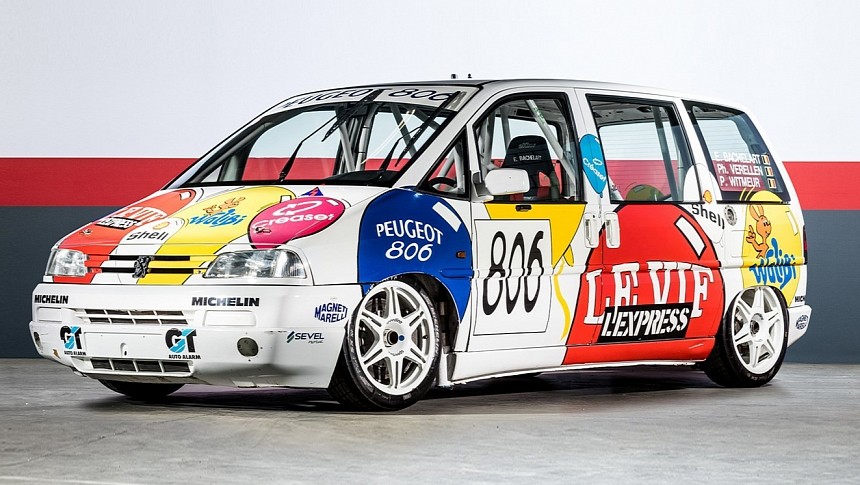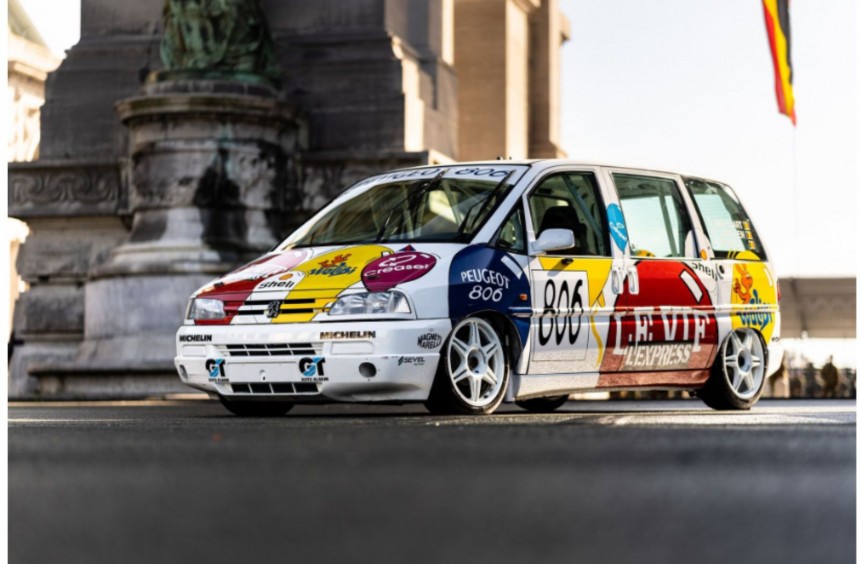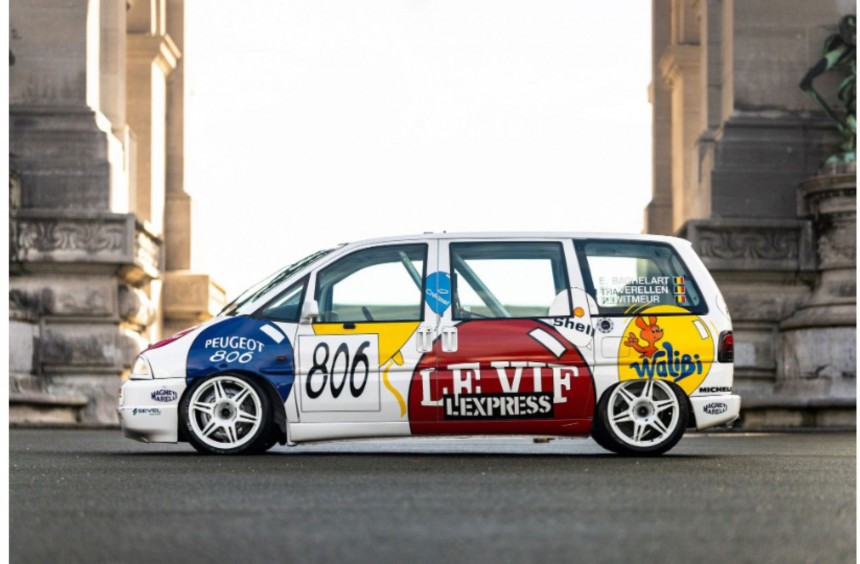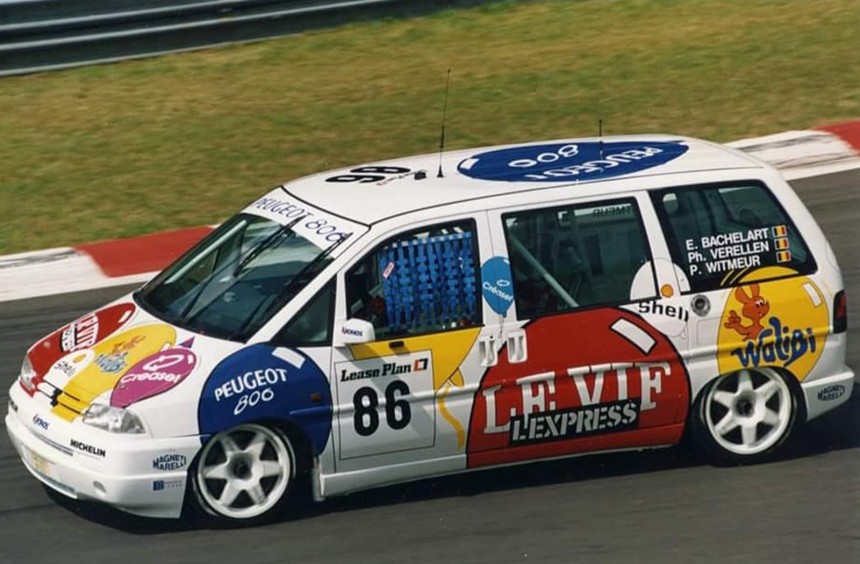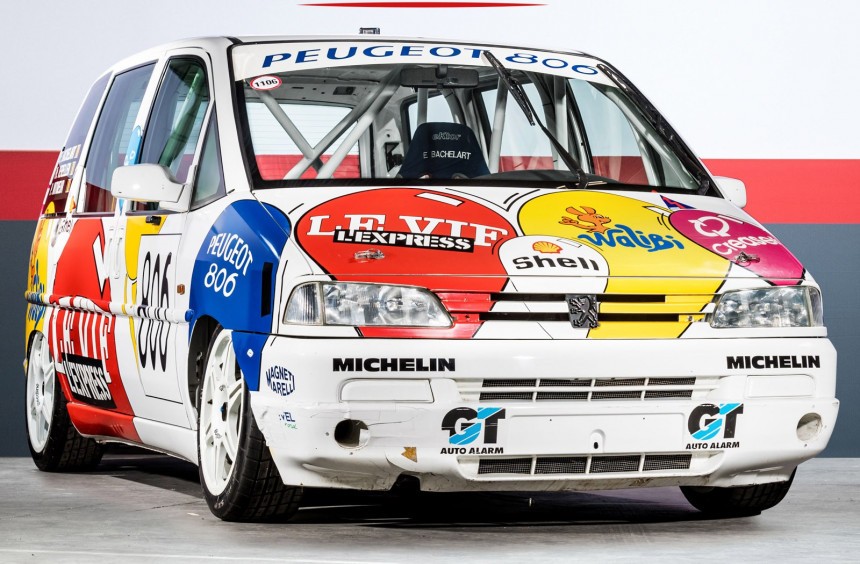Nearly three decades ago, this modified Peugeot 806 became the first and only minivan that ever competed in an FIA-sanctioned 24-hour race.
While it might not be a household name in the US, Peugeot is a renowned automotive marque in Europe and other parts of the world. Currently owned by the Stellantis corporation, the French brand has been heavily involved in motorsport for over a century.
Some of its most outstanding achievements came in the world of rallying, where the factory-backed team won the World Rally Championship Manufacturer's title five times, the famous Dakar rally on seven occasions, and the European Rally Championship three times.
It also competed in endurance racing during the 1990s, winning the World Sportscar Championship’s team and drivers’ trophies in 1992. In addition, Peugeot was triumphant on home soil at Le Mans, the famous endurance race it won in 1992, 1993, and 2009.
For most experts, the best race car that Peugeot ever built was the 905, which saw action on the endurance circuit between 1990 and 1993. But, if we were to pick the most outrageous Peugeot-badged machine that ever competed in an official endurance race, that would have to be the 806 Procar.
Launched in 1994 as part of the first generation of the Eurovan family, the Peugeot 806 shared its platform and drivetrains with the Citroën Evasion, Fiat Ulysse, and Lancia Zeta. Like its siblings, it was a conventional minivan (or MPV in Europe) developed for those that needed a family vehicle that offered plenty of room for passengers and cargo during an era when SUVs - as we know them today – didn’t exist.
Shortly after unveiling the minivan, Peugeot’s marketing department sought ways to boost its popularity on the continent. Someone jokingly suggested that they take a page from Ford’s marketing books and create a wild, race-bred version, and that crazy idea soon turned into reality.
However, unlike the Blue Oval’s series of three Transit-based Supervans that were not much more than promotional vehicles, the French marketing specialists decided to homologate their minivan for competition and enter it into one of Europe’s most prestigious 24-hour races.
Peugeot set their sights on the Belgian Touring Car Series, mainly the 24 Hours of Spa-Francorchamps race, where the minivan could theoretically compete in the Procar 2 category. But, the vehicle needed a complete makeover to gain homologation, so the marketing team hired a Belgian team called Kronos Racing to do the job.
In stock form, there was absolutely nothing sporty about the 806. Relatively big and boxy, it was nothing more than your average people-mover, so it had to be taken apart. Left with a stripped body shell, the Kronos engineers reinforced the structure in critical areas, added an FIA-approved roll cage, then combined everything with a modified chassis taken from a Peugeot 405 Mi16 Supertourisme racing car.
Power came from a 2.0-liter four-cylinder, but it had nothing to do with the similar engines available on the mass-produced version. The powerplant put together by Kronos featured a block sourced from a 306 rally car, a modified cylinder head from the 405 touring car, and a completely custom steel valvetrain that was developed to improve reliability to endurance racing standards.
Mated to a racing transmission also borrowed from the 405 race car, the beefed-up minivan could make up to 280 hp (284 PS), a figure limited by Procar 2 regulations.
The 806 Procar was finished in a matter of months, and after some rigorous testing, it was time to compete in the 24-hour race held on the iconic Spa-Francorchamps in Stavelot, Belgium.
For the 1995 edition of the race, Peugeot lined-up two 306 S16s, a 306 Turbo Diesel, and a 205 GTi, but the fan-favorite was, without a doubt, the 806 co-driven by Eric Bachelart, Philippe Verellen, and Pascal Witmeur.
During practice, the minivan surprised everyone by recording the 3rd fastest lap in its class. Then, during the qualifying session, it remained the 3rd fastest entry in the Procar class and finished 12th overall, showing that it was much more than a promotional vehicle.
However, during the race, the 806 was plagued by numerous issues which started occurring after only about an hour on the track. About nine hours later, the custom engine gave away, and the team was forced to retire the epic minivan.
Although it failed to finish the race, the 806 Procar served its purpose, becoming a cult hero among endurance racing fans. It was featured in numerous publications worldwide and ultimately helped boost the popularity of its dull, street-legal sibling.
After retiring from racing duties, the unique minivan became part of Kronos Racing founder Jean-Pierre Montron’s personal collection. Its engine and gearbox were stripped off and used by the team on another race car, but the rest of the 806 was kept in mint condition.
After Montron passed away, his successors decided to part ways with the Procar, which a private collector acquired. More recently, the famous Peugeot was put on the auction block via Aguttes, with an estimated price between $37,000 and $53,000.
Both a promotional vehicle and an actual race car, the Peugeot 806 Procar went down in history as the first and only minivan to compete in an FIA-sanctioned endurance race. Its story is still fascinating today, nearly three decades after it took to the track, even if it never managed to finish the only endurance race it competed in.
Thanks to the YouTube channel Champion Communication, you can watch actual footage from the 24-hour race in the video below.
Some of its most outstanding achievements came in the world of rallying, where the factory-backed team won the World Rally Championship Manufacturer's title five times, the famous Dakar rally on seven occasions, and the European Rally Championship three times.
It also competed in endurance racing during the 1990s, winning the World Sportscar Championship’s team and drivers’ trophies in 1992. In addition, Peugeot was triumphant on home soil at Le Mans, the famous endurance race it won in 1992, 1993, and 2009.
For most experts, the best race car that Peugeot ever built was the 905, which saw action on the endurance circuit between 1990 and 1993. But, if we were to pick the most outrageous Peugeot-badged machine that ever competed in an official endurance race, that would have to be the 806 Procar.
Born out of a crazy idea
Shortly after unveiling the minivan, Peugeot’s marketing department sought ways to boost its popularity on the continent. Someone jokingly suggested that they take a page from Ford’s marketing books and create a wild, race-bred version, and that crazy idea soon turned into reality.
However, unlike the Blue Oval’s series of three Transit-based Supervans that were not much more than promotional vehicles, the French marketing specialists decided to homologate their minivan for competition and enter it into one of Europe’s most prestigious 24-hour races.
An uninspiring minivan converted into a Group A racer
In stock form, there was absolutely nothing sporty about the 806. Relatively big and boxy, it was nothing more than your average people-mover, so it had to be taken apart. Left with a stripped body shell, the Kronos engineers reinforced the structure in critical areas, added an FIA-approved roll cage, then combined everything with a modified chassis taken from a Peugeot 405 Mi16 Supertourisme racing car.
Power came from a 2.0-liter four-cylinder, but it had nothing to do with the similar engines available on the mass-produced version. The powerplant put together by Kronos featured a block sourced from a 306 rally car, a modified cylinder head from the 405 touring car, and a completely custom steel valvetrain that was developed to improve reliability to endurance racing standards.
Mated to a racing transmission also borrowed from the 405 race car, the beefed-up minivan could make up to 280 hp (284 PS), a figure limited by Procar 2 regulations.
The 1995 Spa-Francorchamps 24 Hours race
For the 1995 edition of the race, Peugeot lined-up two 306 S16s, a 306 Turbo Diesel, and a 205 GTi, but the fan-favorite was, without a doubt, the 806 co-driven by Eric Bachelart, Philippe Verellen, and Pascal Witmeur.
During practice, the minivan surprised everyone by recording the 3rd fastest lap in its class. Then, during the qualifying session, it remained the 3rd fastest entry in the Procar class and finished 12th overall, showing that it was much more than a promotional vehicle.
However, during the race, the 806 was plagued by numerous issues which started occurring after only about an hour on the track. About nine hours later, the custom engine gave away, and the team was forced to retire the epic minivan.
It survived and was recently auctioned off
After retiring from racing duties, the unique minivan became part of Kronos Racing founder Jean-Pierre Montron’s personal collection. Its engine and gearbox were stripped off and used by the team on another race car, but the rest of the 806 was kept in mint condition.
After Montron passed away, his successors decided to part ways with the Procar, which a private collector acquired. More recently, the famous Peugeot was put on the auction block via Aguttes, with an estimated price between $37,000 and $53,000.
Both a promotional vehicle and an actual race car, the Peugeot 806 Procar went down in history as the first and only minivan to compete in an FIA-sanctioned endurance race. Its story is still fascinating today, nearly three decades after it took to the track, even if it never managed to finish the only endurance race it competed in.
Thanks to the YouTube channel Champion Communication, you can watch actual footage from the 24-hour race in the video below.
